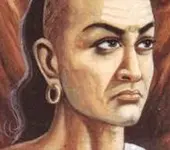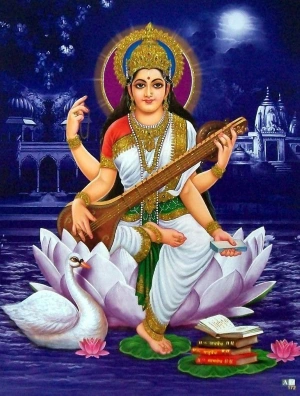Background Of Srividya Sadhana
Transcript
(Click here to read more)
We will look at some very basic aspects of Srividya Sadhana. Who is Srividya? She is the Devi associated with Sri Chakra or Sri Yantra. As we have seen before, Srividya, Sridevi or the Goddess Sri Chakra is Maha Tripurasundari. She is Mahakamesha Mahishi, wife of, queen of Kamesha. Who is Kamesha ? Shiva. She is Narayana's sister. Sriman Narayana only performed her kanyadanam to Shiva. Sri Vidya is made up of two terms - Sri and Vidya. Vidya is derived from Vid which means 'to know'. Vidya means knowledge.....
Transcript
(Click here)
We will look at some very basic aspects of Srividya Sadhana.
Who is Srividya?
She is the Devi associated with Sri Chakra or Sri Yantra.
As we have seen before, Srividya, Sridevi or the Goddess Sri Chakra is Maha Tripurasundari.
She is Mahakamesha Mahishi, wife of, queen of Kamesha.
Who is Kamesha ?
Shiva.
She is Narayana's sister.
Sriman Narayana only performed her kanyadanam to Shiva.
Sri Vidya is made up of two terms - Sri and Vidya.
Vidya is derived from Vid which means 'to know'.
Vidya means knowledge.
Sri is generally associated prosperity, aiswarya, Lakshmi Devi.
But in Srividya, Sri means - श्रियते सर्वैरिति श्रीः
Everyone and everything depend on her.
Now, Srividya is part of the Dasa Mahavidyas.
The Dasa Mahavidyas are classified into 3 groups.
Kali and Tara are Mahavidyas.
Matangi, Kamala and Bagalamukhi are Siddha-vidyas.
Tripura, Bhuvaneswari, Bhairavi, Chhinnamasta, and Dhumavati are called just Vidyas.
The Siddha-vidyas, Matangi, Kamala, and Bagalamukhi are for very serious and rigorous sadhakas. The sadhana involves rituals that common man will not be able to do.
Mahavidyas, Kali and Tara are even risky.
They should be undertaken only by those who have well progressed in the spiritual path and attained detachment from the world.
This doen't mean that ordinary people should not worship these Devatas.
Absolutely, they can.
You can chant their stotras, go to their temples, pray to them
….
But undertaking their sadhana, you have to be careful and always under the
guidance of a capable Guru who can be by your side in hours of crisis.
Not that, some Baba Ji gave you Kali Mantra and disappeared.
No, please don't do that.
These sadhanas are very very powerful and fraught with dangers.
Your Guru should be available to you 24X7.
The other five vidyas, Tripura, Bhuvaneswari, Bhairavi, Chhinnamasta, and Dhumavati are soft and suitable even for beginners.
Out of these, Devi Tripurasunhdari or Srividya is very loving, kind, and benevolent.
Now, some specialties on Srividya upasana -
Srividya sadhana is very popular and very systematic.
Originally, there were many systems of sadhana or schools of sadhana.
Currently, only two are in existence.
The one started by Manmatha and continued by Agastya.
And the one propounded by Agastya's wife, Lopamudra.
The first one is called Kadi-matha and the second one is called Hadi-matha.
There is also a third one, Sadi matha.
These are based on the three groups of the Panchadashi Mantra of Sri Vidya,
क ए ई ल ह्रीं
ह स क ह ल ह्रीं
स क ल ह्रीं
The first group called Vagbhavakuta starts with Kakara and is satwik.
The second group which starts with Hakara is called Kamarajakuta, this is rajasik.
The third group which starts with Sakara is called Shaktikuta. this is tamasik.
The procedure of worship are mainly 3 - Hayagriva Sampradaya, Ananda-Bhairava Sampradaya, and Dakshinamurthy Sampradaya.
Hayagriva Sampradaya and Dakshinamurthy Sampradaya are satwik.
Ananda-Bhairava Sampradaya involves Pancha-makra sadhana with liquor and meat and is to be undertaken only by very advanced and evolved sadhakas.
Puja of Srichakra is called Navavarana Puja.
This is because in Srichakra, the placement of deities is in 9 concentric layers.
The peak point at the centre is called Bindu and the square at the periphery is called Bhupura.
There are 3 sequences in which the Navavarana puja is performed.
From the Bindu towards the Bhupura is called Srishti-krama.
From the Bhupura towards the Bindu is called Samhara-krama.
From Bhupura till midway and then from Bindu till midway is called Stithi-krama.
The Srividya Mantra called Panchadashi is made up of three groups of letters as we have seen earlier.
They represent the body of the Devi.
The Vagbhavakuta is her face, Kamarajakuta is from neck to waist and Shaktikuta is below the waist.
As you might have noticed, the world exists in triads.
Satwa-rajas-tamas
Surya-Chandra-Agni
Srishti-stithi-samhara
Iccha-jnana-kriya shaktis
Jagrat-swapna-sushupti
Manasika-vachika-kayika karmas
Past-present-future
Atma-antaratma-paramatma
Srividya Mantra with its trikuta format represent all these.
While the Mantra is the verbal expression of the Devi's body, Srichakra is its physical expression.
If you add Srim to the end of Panchadashi, it becomes Shodashi.
There is also another Mantra called Mahashodashi with 27 letters.
Bala Mantra is also trikuta with just 3 letters.
Those who are initiated into Srividya sadhana should definitely make effort to understand the structure of Srichakra and its intricacies.
We have a section in Vedadhara website called Story of Sri yantra connecting the legend of Lalita Devi with Srichakra.

English Topics
Devi
Click on any topic to open
- 47 A Man Becomes a Woman and Again a Man
- 46 Prayer To Saraswati Devi
- 45 Background Of Srividya Sadhana
- 44 Do you know what happened when Gowri and Lakshmi deserted their husbands?
- 43 Why Devi Is Called Chandee
- 42 Why Pujas Should Be Done By Husband And Wife Together
- 41 Lakshmi Devi Had Become A Horse Once. Do You Know This Story?
- 40 Atomic theory of Vaisheshika connected to Devi
- 39 Important Messages From Durga Saptashati
- 38 Aditi The Mother Of Devas
Please wait while the audio list loads..
30
Ganapathy
Shiva
Hanuman
Devi
Vishnu Sahasranama
Mahabharatam
Practical Wisdom
Yoga Vasishta
Vedas
Rituals
Rare Topics
Devi Mahatmyam
Glory of Venkatesha
Shani Mahatmya
Story of Sri Yantra
Rudram Explained
Atharva Sheersha
Sri Suktam
Kathopanishad
Ramayana
Mystique
Mantra Shastra
Bharat Matha
Bhagavatam
Astrology
Temples
Spiritual books
Purana Stories
Festivals
Sages and Saints



